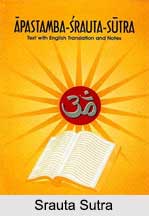 Srauta Sutras are based on older Vedic Literature. The Srauta Sutras along with Grihya Sutras, Sulba Sutras and the Dharma Sutras make up the Kalpa sutras. They form a part of Sanskrit literature. It consists of instructions relating to use of the Shruti, a corpus in ritual and the manner of performance of rituals. Srauta Sutras form a very important unit of the Sutras literature which lays down in brief the quintessence of the Vedic texts strengthening further the sacrificial tradition in India.
Srauta Sutras are based on older Vedic Literature. The Srauta Sutras along with Grihya Sutras, Sulba Sutras and the Dharma Sutras make up the Kalpa sutras. They form a part of Sanskrit literature. It consists of instructions relating to use of the Shruti, a corpus in ritual and the manner of performance of rituals. Srauta Sutras form a very important unit of the Sutras literature which lays down in brief the quintessence of the Vedic texts strengthening further the sacrificial tradition in India.
Composition of Srauta Sutra
Some of the early Srauta sutras were composed in the late Brahmana period like Baudhayana and Vadhula Sutras. However most of them are contemporaries to Grihya corpus of domestic Sutras. The language used is the late Vedic Sanskrit dating back to the mid first millennium before the age of Panini.
Content of Srauta Sutra
Srauta Sutra, any of a number of Hindu ritual manuals used by priests engaged in the performance of the grander Vedic sacrifices, those requiring three fires and the services of many specialized priests. Each Srauta Sutra guides the priests of its own particular Vedic school in the performance of specialized functions. The texts deal with such subjects as the laying of the three fires, the full and new moon ceremonies, and the various animal and soma sacrifices.
In brief, the Sutras lay down the essence of the Vedic texts like that of the Samhitas and Brahmanas. The Baudhayana Srauta Sutra is a late Vedic text that deals with the solemn rituals of the Taittiriya School of the black Yajur Veda which was composed during the late Brahmana period in eastern Uttar Pradesh.
This article is a stub. You can enrich by adding more information to it. Send your Write Up to content@indianetzone.com




















